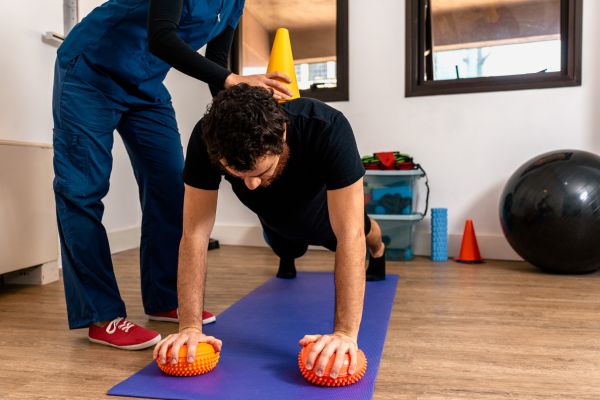Muscle strains. Ugh. If you’ve ever pulled a muscle mid-game or during your workout, you know the pain is real. One second you’re in the zone, and the next—bam! You’re holding your leg, back, or shoulder, wondering what just happened. The thing is, muscle strain is super common, especially for people who play sports, hit the gym regularly, or even just overdo it during weekend chores. The good news? Muscle strain treatment isn’t as scary as it sounds, and with the right steps, you can bounce back faster than you think.
Let’s break it all down in plain English.
What Exactly Is a Muscle Strain?
Okay, before we jump into muscle strain treatment, let’s understand what we’re dealing with. A muscle strain, sometimes called a pulled muscle, happens when your muscle fibers overstretch or tear. This usually goes down when you move too suddenly, lift something too heavy, or forget to warm up properly (yeah, we’re all guilty of skipping warm-ups sometimes).
You might feel a sharp pain, swelling, or weakness in the muscle. Sometimes it’s mild—just a nagging ache. Other times, it can stop you in your tracks.
The First 48 Hours Matter Most
Here’s the thing: how you handle the first two days after a strain can seriously affect how fast you heal.
Right after you feel that twinge or pop, your body starts reacting—swelling, bruising, and inflammation kick in. So what do you do? The classic RICE method is still gold.
Rest is key. That doesn’t mean lying in bed all day, but avoid using the injured muscle. Let it chill.
Ice the area for about 15–20 minutes every couple of hours. Cold helps reduce swelling and numbs the pain a bit. Don’t put the ice directly on your skin—wrap it in a towel.
Compression with an elastic bandage can help control swelling. Just don’t wrap it too tight—you don’t want to cut off circulation.
Elevation is simple: keep the injured area above heart level if you can. This helps move fluids away and eases swelling.
That’s your starter pack for muscle strain treatment. But it doesn’t stop there.
When to See a Doctor (Because Sometimes You Should)
Let’s be real. Not every pulled muscle needs a doctor’s visit. But if you heard a loud pop, if the pain is insane, or if the area looks deformed, don’t try to tough it out. Go see a doc. You might have a serious tear, and that’s not something ice and rest alone will fix.
Even if it seems mild but it doesn’t improve after a week or two, it’s better to get checked out. Peace of mind is worth it.
Easing Back Into Movement
Once the swelling and pain go down a bit, it’s tempting to get back into action. But slow your roll.
Gentle stretching can help your muscle regain flexibility, but don’t force it. If it hurts, stop. Light movement like walking or range-of-motion exercises can improve blood flow and speed up recovery.
Physical therapy can be a game changer too. A trained therapist will guide you with specific moves to rebuild strength and prevent the same injury from happening again. And honestly? Sometimes just having someone guide you makes it way easier to stay motivated.
Heat Therapy: When and Why
Cold is for the beginning, but once you’re past that initial phase, heat can step in.
Heat therapy can relax tight muscles, increase blood flow, and soothe lingering aches. Think warm showers, heating pads, or even warm towels. Just be sure the inflammation is gone before you start. Otherwise, you’ll just make things worse.
So yeah—muscle strain treatment shifts as your body heals. That’s normal.
Over-the-Counter Helpers
Sometimes the pain needs a little extra help. Over-the-counter anti-inflammatories like ibuprofen or naproxen can reduce pain and swelling. Just follow the dosage and don’t pop them like candy. They’re helpful, but they’re not magic.
If creams or gels are more your style, there are topical options that can give some relief too. No shame in using what works.
Nutrition and Hydration: Underrated but Important
Here’s something most people overlook in muscle strain treatment: what you eat and drink matters.
Your body needs fuel to heal. Protein helps repair muscle fibers, vitamin C aids collagen production, and zinc boosts tissue healing. Toss in some omega-3s for anti-inflammatory power, and you’re golden.
Also—hydration. Muscles need water to function and recover. If you’re not drinking enough, your recovery could slow down. Water, electrolyte drinks, herbal teas—whatever keeps you sipping.
The Mental Side of Healing
Okay, so this part isn’t talked about enough. Being sidelined with an injury sucks. It can make you feel frustrated, restless, even a little down.
That’s totally normal.
Whether you’re an athlete or just someone who enjoys moving, taking time off can mess with your head. Stay connected to your routine in other ways—maybe focus on nutrition, mindset, or upper-body workouts if your leg is injured. Keep your brain in the game, even if your body needs a breather.
Remember: healing isn’t just physical. It’s mental too.
How to Prevent It from Happening Again
Nobody wants to go through muscle strain treatment more than once if they can help it.
So what can you do?
Warm up. Seriously. A five-minute warm-up can do wonders. Think dynamic stretches, not static ones. Save those for post-workout.
Don’t skip strength training. Strong muscles are less likely to get injured. And balance your workouts—don’t just hammer the same muscle group every day.
Also, listen to your body. Pain is your body’s way of waving a red flag. Don’t ignore it.
Lastly, rest. Recovery is just as important as training. Sleep well. Take rest days. Your muscles need it.
Wrapping It Up
At the end of the day, muscle strain treatment isn’t rocket science, but it does take some attention and care. From icing in the first 48 hours to easing back into movement and giving your body the fuel it needs, it’s all about working with your body, not against it.
And hey, injuries happen. They’re part of the process. What matters is how you respond—smart choices, a little patience, and some good old self-care can make all the difference.
So next time your muscles cry out mid-game or during a lift, you’ll know what to do. Heal up, take it easy, and come back stronger. You got this.





